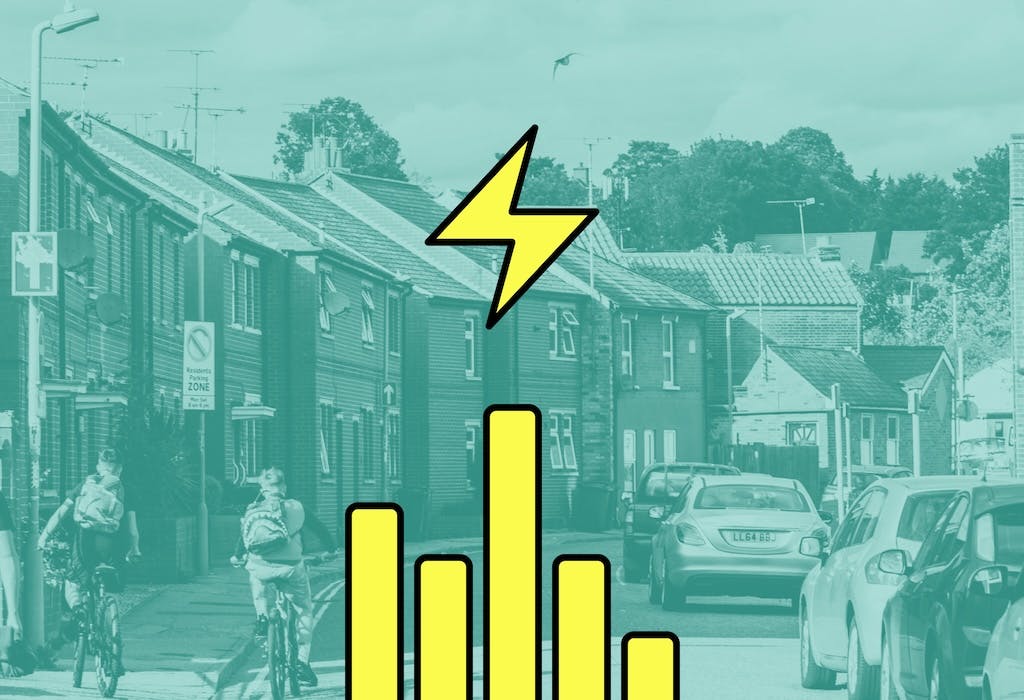UK electricity consumption statistics
Check out our UK electricity consumption statistics, including how much we use, how this compares to Europe, and what the long term forecasts are.
Written byMelody Abeni

Calculate savings
What kind of home do you live in?
Calculate savings
What kind of home do you live in?
At a glance
🏠 The average UK household consumes 3,449kWh of electricity per year
📉 Average household consumption has fallen by 26% since 2007
🏘️ The residential sector uses the most electricity in the UK
🌬️ Wind and gas are the largest contributors to the UK’s electricity generation
⚡ UK electricity demand will surge due to electric cars and heat pumps
Back in 1881, the UK installed its first public electricity generator in Surrey, and since then the nation hasn’t looked back. Electricity is absolutely central to our lives, and it’s about to become even more so.
In this article, we explore nine key areas of electricity consumption in the UK, from average household usage, how it’s changed over time, how it compares to the rest of Europe, and what the future holds.
If you’re feeling the pinch from high electricity bills, it’s worth considering the switch to solar. To find out how much you could save with a solar & battery system, just enter a few details below and we’ll provide an estimate.
Average annual electricity consumption by household
According to the latest government data from December 2024, the average British household uses 3,449 kilowatt-hours (kWh) of electricity per year.
This figure has fallen gradually over the past few years, as we explore further down.
Average daily electricity consumption by household
Based on the average annual electricity consumption of 3,449kWh per household, the average daily household consumption works out to approximately 9.45kWh.
While this provides a useful benchmark, it’s important to note that a household’s actual daily consumption will vary throughout the year, with a peak in winter.

Electricity consumption by season
Data from 2019 shows that electricity consumption in the UK varies slightly by season.
On average, homes use the most power in winter (941kWh per day), the least in summer (741kWh per day), with spring and autumn figures hovering in between, at 818kWh per day and 837kWh per day, respectively.
These seasonal fluctuations aren’t particularly dramatic, namely because colder weather tends to increase gas consumption much more than it does electricity.
However, with more homes switching to heat pumps (which rely on electricity), it’s likely we’ll see increased seasonal fluctuations in electricity usage.
UK electricity demand by season
Change in electricity consumption over time
Between 2007 and 2023, the average annual electricity consumption per UK household dropped significantly, falling by 26% from 4,662kWh to 3,449kWh.
According to analysis by Drax, this decline is due to improved efficiency in appliances such as lighting, television and fridges.
Rising energy prices have also encouraged households to cut back on their usage, with many adopting smarter energy habits to reduce their bills.
But as more homes switch to electric vehicles and heat pumps, electricity demand is predicted to shoot up. In fact, according to the Climate Change Committee, by 2050 the UK’s annual electricity demand could be more than double 2023 levels (more on this below).
UK electricity demand, 2005-2023
Electricity consumption by country/region
There are some slight variations in electricity use across Great Britain, according to government data published in December 2024.
In England, average annual household electricity consumption stands at 3,462kWh, followed by Scotland at 3,429kWh, and then Wales at 3,213kWh.
At the local level, government figures show that the Isle of Scilly has the highest annual mean consumption at 8,665kWh per household, while South Tyneside has the lowest at 2,568kWh.
Electricity consumption per capita vs Europe
According to the International Energy Agency (IEA), the UK’s electricity consumption per capita was 4.3 megawatt-hours (MWh) in 2022.
This figure differs from household consumption, as it represents the total national electricity use (including all domestic and industrial demand) divided by the UK’s population.
Surprisingly, the UK ranks 33rd out of 43 European countries for per capita electricity consumption on the IEA's list - a relatively low position.
Meanwhile, the top five countries are Iceland, Norway, Finland, Sweden, and Luxembourg.
Electricity generation by source
The National Energy System Operator (NESO) reported that the UK’s electricity generation came from nine key sources in 2024, with wind and gas being the largest contributors.
Wind accounted for 30% of electricity generation, making it the leading source for the first time, while gas followed closely at 28%. Other sources included nuclear, solar, hydro, and imports, with coal contributing just 0.6%.
To learn more, check out our guide to the UK’s renewable energy usage.
UK electricity generation by source, 2024
Electricity consumption by sector
The UK's residential sector used the most electricity in 2023, accounting for 34% of the total, according to IEA analysis.
This was closely followed by industrial use (32%), commercial and public services (28.2%), and transport (4.1%), with agriculture, forestry, and fishing making up the rest.
The transport sector has such low electricity consumption because it still relies heavily on fossil fuels. In fact, the sector gets a whopping 91% of its energy from oil products.
And while it accounts for only 4.1% of the UK's electricity use, it dominates the nation’s overall energy consumption, making up 34% of total energy demand.
As the UK continues to electrify its vehicles and trains, we can expect a dramatic increase in the transport sector's reliance on electricity.
UK electricity consumption by sector, 2023
Future electricity consumption
With fossil fuels on their way out, we will see the UK’s electricity consumption spike. As electric vehicles and heat pumps become the norm, the UK's electricity demand is forecast to skyrocket.
The Climate Change Committee’s 7th Carbon Budget projects a substantial rise in annual electricity demand, from 279 terawatt-hours (TWh) in 2025 to 333TWh in 2030, 562TWh in 2040, and a mighty 692TWh in 2050.
Summary
Average household electricity consumption has fallen steadily over the past 20 years, but it’s expected to start moving in the opposite direction as heat pumps and electric cars sweep the nation.
However, electricity bills are expected to stay high until at least the late 2030s, making energy efficiency and renewable sources more important than ever.
If you’re wondering how much you could save with a solar & battery system, answer a few quick questions below and we’ll generate an estimate.

Written byMelody Abeni
Based in London, Melody is a specialist green technology writer who has been covering sustainability, climate action and ESG for the past five years, after gathering operational experience in green investing and financial services. She has written for various industry publications, including renewable technology advisor The Eco Experts, and she holds a Master’s degree in law from Birkbeck University.